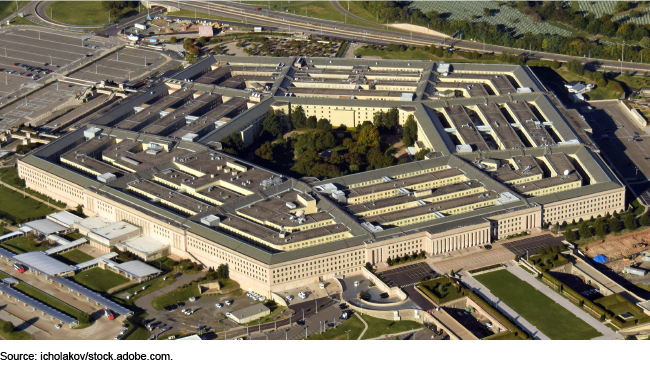Defense Industrial Base: DOD Needs Better Insight into Risks from Mergers and Acquisitions
Fast Facts
Mergers and acquisitions affect the companies directly involved—and their customers. When the customer is the Department of Defense, mergers can affect competition for defense contracts, increase prices, or reduce innovation.
DOD assesses only a portion of defense mergers and acquisitions each year, generally when the antitrust agencies—the Department of Justice and Federal Trade Commission—ask for DOD's input for antitrust reviews of these transactions. In these cases, DOD assesses competition risks.
With this approach, DOD may overlook critical defense industry risks. Our recommendations would help DOD proactively assess merger risks.

Highlights
What GAO Found
The Department of Defense (DOD) has estimated that hundreds of defense companies undergo mergers and acquisitions (M&A) each year. DOD's Industrial Base Policy office and DOD stakeholders work together to conduct assessments of such M&A's risks and benefits. When M&A present risks to competition, DOD's Industrial Base Policy office also works with the antitrust agencies, which review and regulate M&A that may substantially lessen competition.

DOD's insight into defense M&A is limited. Industrial Base Policy's M&A office and DOD stakeholders assessed an average of 40 M&A per year in fiscal years 2018 through 2022, which represents a small portion of defense M&A. DOD's most recently published statistics on defense M&A, which were included in its Fiscal Year 2017 Annual Industrial Capabilities report, indicated that approximately 400 defense M&A occurred annually.
Most DOD assessments are initiated in response to antitrust reviews of large M&A valued over a certain dollar threshold, currently $111.4 million. Therefore, Industrial Base Policy's M&A office and DOD stakeholders focus on evaluating competition risks in their M&A assessments. While DOD policy directs Industrial Base Policy and DOD stakeholders to assess other types of risks, such as national security and innovation risks, they have not routinely done so. Moreover, DOD policy does not provide clear direction about which M&A DOD should prioritize for assessment, beyond those conducted in response to antitrust reviews. DOD officials noted that the M&A office—which is comprised of two to three staff—does not have the staff resources to initiate more assessments of smaller M&A that may also present risks. Assessing whether the M&A office has adequate resources to meet its responsibilities and clarifying which defense suppliers' M&A should be prioritized would help DOD better assess risks.
DOD generally does not monitor whether risks identified in its M&A assessments were realized. GAO found that DOD policy does not require Industrial Base Policy and DOD stakeholders to conduct monitoring. As a result, they cannot determine if risks occurred and whether further action is needed to mitigate them.
Why GAO Did This Study
DOD has reported that consolidation of its suppliers through M&A is a key risk imperiling the health and resilience of the defense industrial base. While M&A may create benefits, such as improving a supplier's financial health, they may also reduce competition and increase the risk of higher costs and reduced innovation.
To help manage these risks, DOD has established a process for assessing the potential effects of defense-related M&A. Under certain circumstances, DOD also provides input to the federal antitrust agencies, which review and, when necessary, take action to mitigate competition risks from M&A.
Congressional reports included provisions for GAO to evaluate DOD's efforts to assess the effects of M&A on the defense industrial base. This report assesses (1) the extent to which DOD has insight into defense-related M&A, and (2) the extent to which DOD monitors the effects of M&A on the defense industrial base, among other things. GAO reviewed agency policy and documentation, analyzed agency-provided and commercially available data, and interviewed agency officials.
Recommendations
GAO is making four recommendations for DOD to: provide additional direction on assessing all risks and benefits identified in policy, clarify which defense suppliers' M&A need to be prioritized for assessment, assess whether Industrial Base Policy's M&A office is adequately resourced, and require monitoring of identified risks. DOD concurred with the recommendations and described its actions to address them.
Recommendations for Executive Action
| Agency Affected | Recommendation | Status |
|---|---|---|
| Department of Defense | The Secretary of Defense should ensure that the Assistant Secretary of Defense for Industrial Base Policy provides clear direction as to which major defense suppliers IBP should prioritize for the purposes of conducting M&A assessments. (Recommendation 1) |
DOD concurred with the recommendation. In December 2024, the Assistant Secretary of Defense for Industrial Base Policy (IBP) approved criteria that IBP and other DOD stakeholders will use to identify major defense suppliers. The Assistant Secretary also approved an initial list of suppliers that meet the new criteria. As of April 2025, IBP officials said, however, their ability to conduct M&A reviews is limited by resource and budget constraints. If sufficiently resourced, IBP officials intend to track these major defense suppliers to determine if any are engaging in M&A activity that needs to be reviewed and update the list annually. Due to budget and resource constraints, IBP officials said they have not yet distributed the list of major defense suppliers to other DOD stakeholders. Instead, IBP plans to conduct a pilot effort in 2025 to track a subset of these companies for M&A activity. Once IBP completes the pilot and distributes its list of major defense suppliers to DOD stakeholders, we will consider this recommendation addressed. GAO will continue to monitor IBP's actions to address this recommendation.
|
| Department of Defense | The Secretary of Defense should ensure that the Assistant Secretary of Defense for Industrial Base Policy assesses whether its M&A office is adequately resourced to consistently carry out its responsibilities. (Recommendation 2) |
DOD concurred with the recommendation. In 2024, officials from DOD's office of Industrial Base Policy (IBP) conducted a manpower assessment to determine the number of staff they needed to lead DOD's assessments of (1) M&A in support of Hart-Scott-Rodino antitrust reviews and (2) M&A for all major defense suppliers, regardless of valuation. IBP found that its M&A team was not sufficiently resourced to fulfill either of these functions. As of April 2025, IBP officials also stated that they had not yet assessed the manpower needed to monitor concluded M&A for realized risks. Once IBP assesses those additional staffing requirements, we will consider this recommendation fully addressed. GAO will continue to monitor IBP's actions to address this recommendation.
|
| Department of Defense | The Secretary of Defense should ensure that the Assistant Secretary of Defense for Industrial Base Policy provides the Office of Industrial Base Policy and DOD stakeholders with additional direction on assessing the full range of risks and benefits identified in DOD's M&A policy, such as national security effects, when developing the new DOD instruction or other appropriate guidance. (Recommendation 3) |
DOD concurred with the recommendation. In December 2024, the Assistant Secretary of Defense for Industrial Base Policy (IBP) approved a new risk matrix, which provides DOD stakeholders who contribute to M&A assessments with guidance on how to assess 18 different categories of risk that could result from a merger or acquisition. As of April 2025, IBP is also in the process of drafting and coordinating a new DOD Instruction, which would provide further guidance on conducting M&A assessments. Once DOD issues the new instruction with M&A risk assessment guidance, we will consider this recommendation fully addressed. GAO will continue to monitor IBP's actions to address this recommendation.
|
| Department of Defense | The Secretary of Defense should ensure that the Assistant Secretary of Defense for Industrial Base Policy revises DOD's M&A policy to direct the Office of Industrial Base Policy, with support from relevant DOD stakeholders, to monitor the effects of concluded mergers or acquisitions in cases in which DOD identified risks during its assessment, to determine if risks were realized or if additional action is needed. (Recommendation 4) |
DOD concurred with the recommendation. As of April 2025, officials from DOD's office of Industrial Base Policy (IBP) said they planned to add a monitoring function to DOD's M&A guidance, which would require the M&A office and other DOD stakeholders to conduct monitoring of concluded M&A to determine if any risks had materialized for DOD. Due to the effort and time needed to establish this new function, however, IBP officials stated that they will not be able to complete their efforts for this recommendation until the M&A office has additional staff. GAO will continue to monitor IBP's actions to address this recommendation.
|
